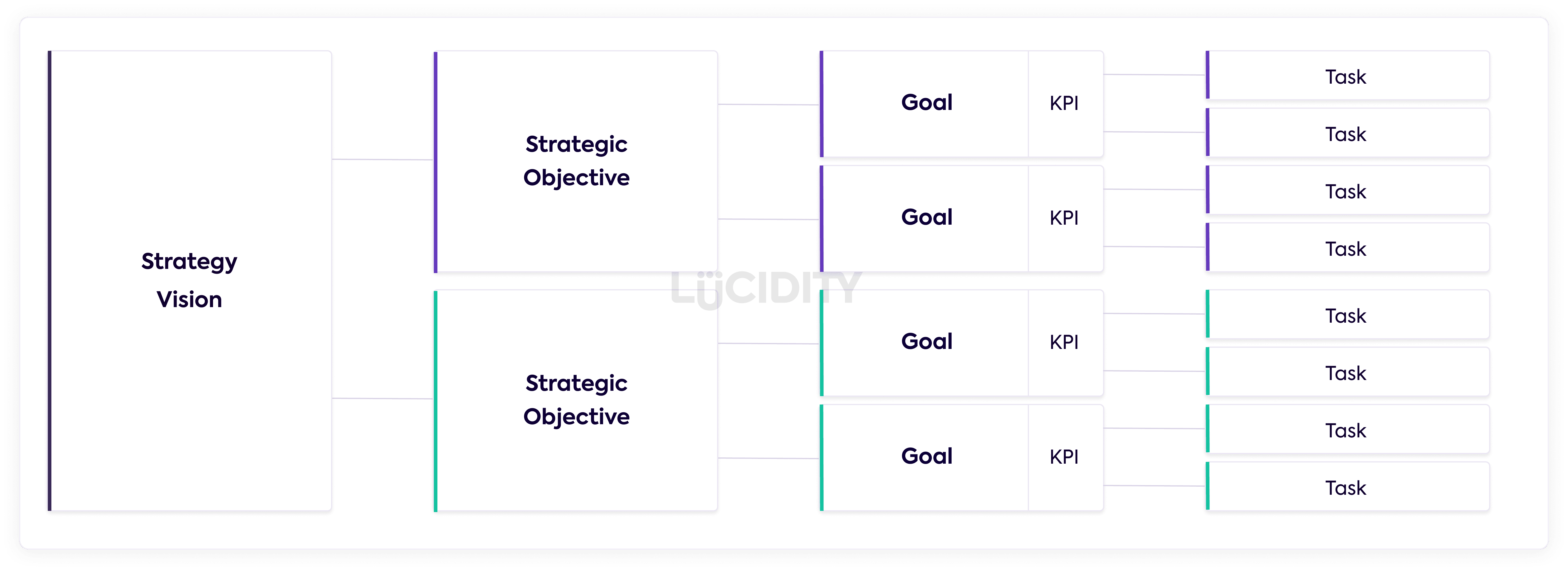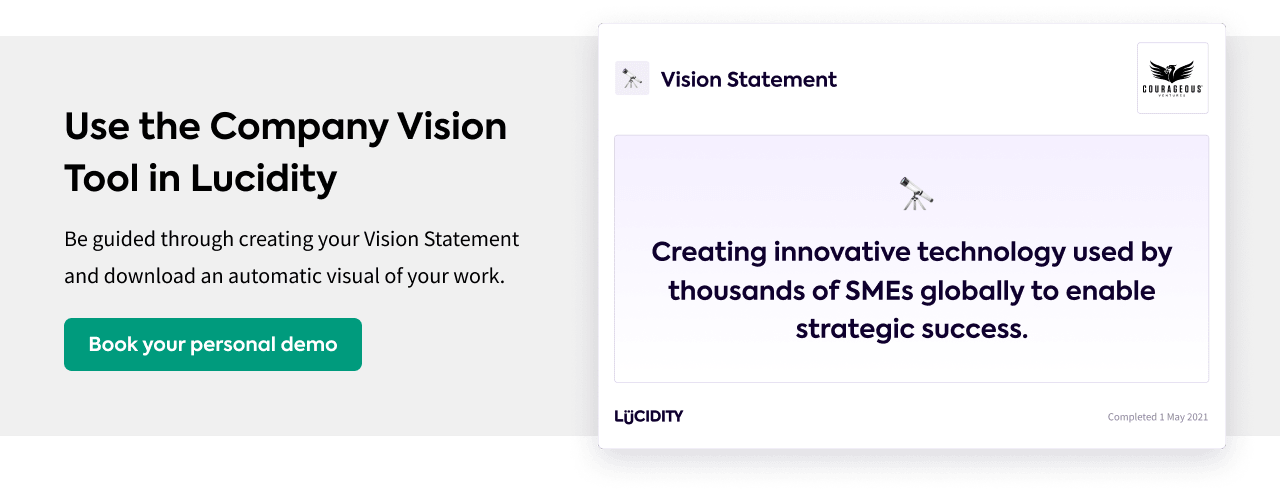One of the best approaches to mapping out your strategy is using something called the Strategy Tree. This framework allows you to analyse, adapt, and communicate your strategic plan, supporting both OKR and KPI models.
Want to know more…? Let’s take a look in more detail!
What is a Strategy Tree?
A Strategy Tree is a way to lay out and define your strategic plan. It can be used to guide your strategy formation, communicate the plan to your team or stakeholders and as a way to report on progress against your overall goals.
As you can see above, a Strategy Tree contains the following elements:
- Vision & Mission
- Strategic Objectives
- Goals & Initiatives
- Tasks
Your Strategy Tree can accommodate different models. For example, if you use the OKR framework then Objectives and Goals become Objectives and Key Results. If you’re an organisation that heavily uses KPIs, then Goals can become the KPIs.
What are the different levels in a Strategy Tree?
Level One: Vision Statement
The start of the Strategy Tree begins with your Vision Statement. Everything from this point on works to support making your Vision a reality. You may also include your Mission Statement at this stage in the Tree too.
If you’d like more information on creating your Vision and Mission then take a look at our Guide to Vision Statements or Guide to Mission Statements.
Level Two: Strategic Objectives
This is quite a big one. Strategic Objectives sit under your Vision/Mission. What are the big things you’re trying to achieve? It could be areas such as Financial Growth or Engaged Customers, or perhaps it’s more specific under an OKR framework?
Your Strategic Objectives are the broad things you want to achieve for the business. Think of these as the headlines of your strategy – it’s these Strategic Objectives that should really stick in the minds of your team. These are the core pillars of your strategy and what you want your font-line staff to remember.
Take a read of our Guide to Strategic Objectives for more guidance and advice on formulating your core objectives.
Level Three: Goals & Initiatives
Now we’re getting into the detail. Goals are the targets you want to achieve. They are the real, tangible, measurable results you need to hit to achieve your Strategic Objectives.
A simple example, which is in all company strategic plans, is the financial based targets. What is the Revenue Goal for your business, what do you need to hit in order for your Objective to become a reality?
If you’re a business that uses OKRs then these are the Key Results. If you favour KPIs, then those key performance indicators would be associated to Goals at this point in your Tree.
Alongside Goals are the concept of Initiatives (or Projects, depending on your terminology). These are activities that happen to support your strategic plan. If you’re working on building a team then Employer Branding may be an initiative, equally if you’re going through the process of installing a new financial system, this too would be an initiative.
Level Four: Tasks
At the end of the tree are Tasks. These are the day-to-day operational activities that have to happen to ensure your Goals & Initiatives are hit. At this level in the tree, you’re into the execution.
Here the structure of the Strategy Tree will enable the team members who are responsible for these tasks to clearly see the contribution they are making to the overall strategic plan. By following the branches back from their specific task, they can effortlessly see the Goal or Initiative they are helping to achieve, then the Strategic Objective that is contributing to, and finally, how that relates to the company vision and mission. Ensuring your people understand their specific contribution to the strategy is of crucial importance when it comes to winning their buy-in, motivating them and therefore, ultimately, ensuring successful execution.
This is one of the main reasons the Lucidity strategy platform is built around a central Strategy Tree. That simple journey through from over-arching vision right down to the detail of checklists against specific tasks is what prevents our customers falling down the ‘execution gap’ and failing to make their strategy happen!
So, these are the levels of a basic Strategy Tree, but of course you could make it slightly more complex. You might have cascaded Goals, or you may have Task dependencies. Ultimately it depends how complicated your strategy is… but keep in mind, the simpler it is, the easier it’ll be to understand!
What preparation is needed to create a Strategy Tree?
As with all strategy models, to create a tree that works you need to do your research. Consider external analysis frameworks (of which there are many, such as PESTLE, Five Forces) as well as internal analysis (such as VRIO or SWOT).
Should all parts of a Strategy Tree have owners?
At operational level, all Tasks need an owner yes. Above tasks? It’s optional but best practise would suggest yes. If you have ownership from team members you’re more likely to have a successful execution.
What are the advantages of a Strategy Tree?
There’s a lot of advantages to a Strategy Tree including:
- It’s a simple and easy to use tool
- It gives a clear and easily digestible way to communicate out your strategic plan
- It’s a useful tool to work as an agenda for board meetings
- It breaks down a top-level Vision to operational activities
- Everyone knows how they contribute to the strategy
- It highlights any areas that may be lacking focus
What are the disadvantages of a Strategy Tree?
Strategy Trees are good models for structure but there are some considerations:
- They don’t include the ‘why’ from your research
- They can become large if not regularly pruned
What are the alternatives to a Strategy Tree?
Take a look at the Strategy Map and VMOST Analysis, both of which offer a way to present a strategic plan.
Are there software applications to help you create your Strategy Tree?
Lucidity! Hello 👋
As mentioned, we offer the Strategy Tree as one way to develop your strategic plan in the system.
Build your strategy tree with templates & examples
Book your personal demo and we'll generate a tailored strategy template that's right for you - well structured, logically laid-out and easy to understand.













